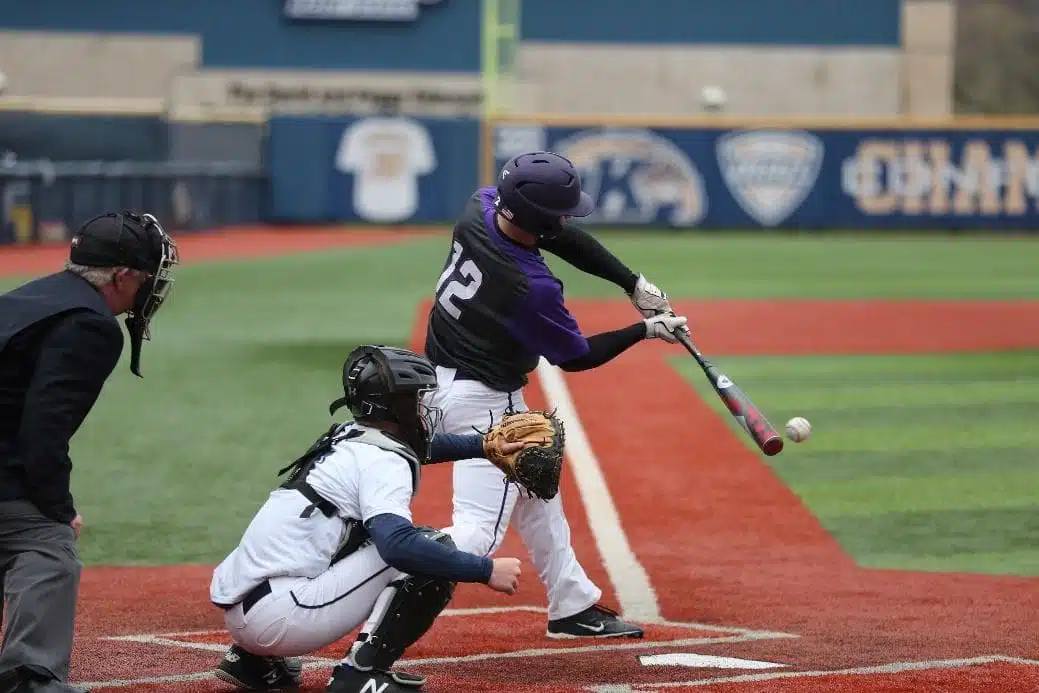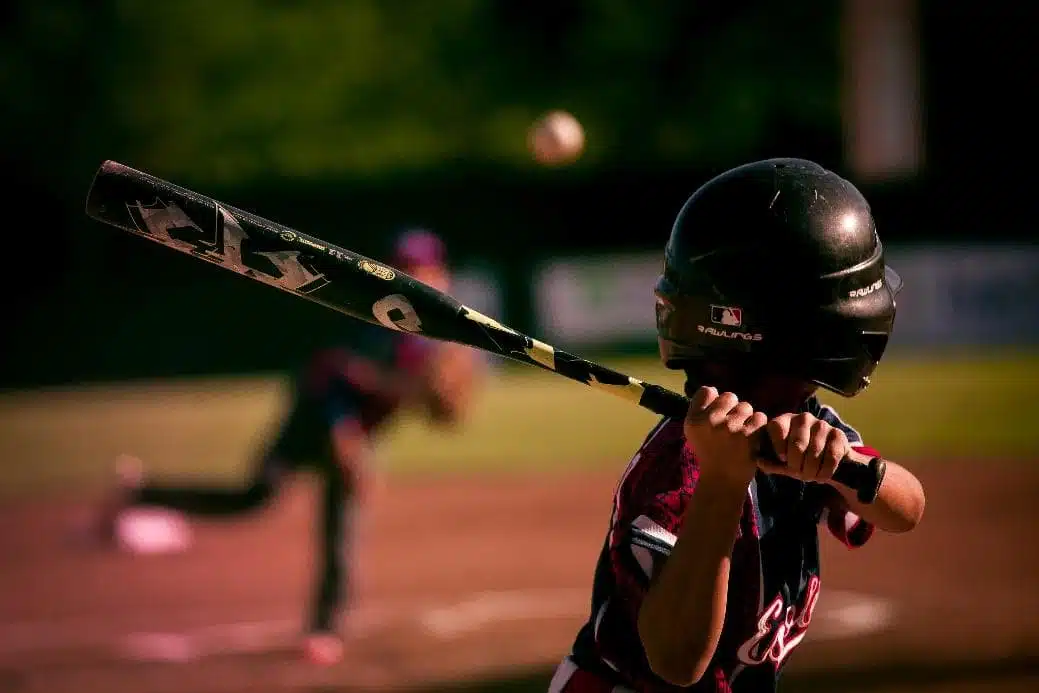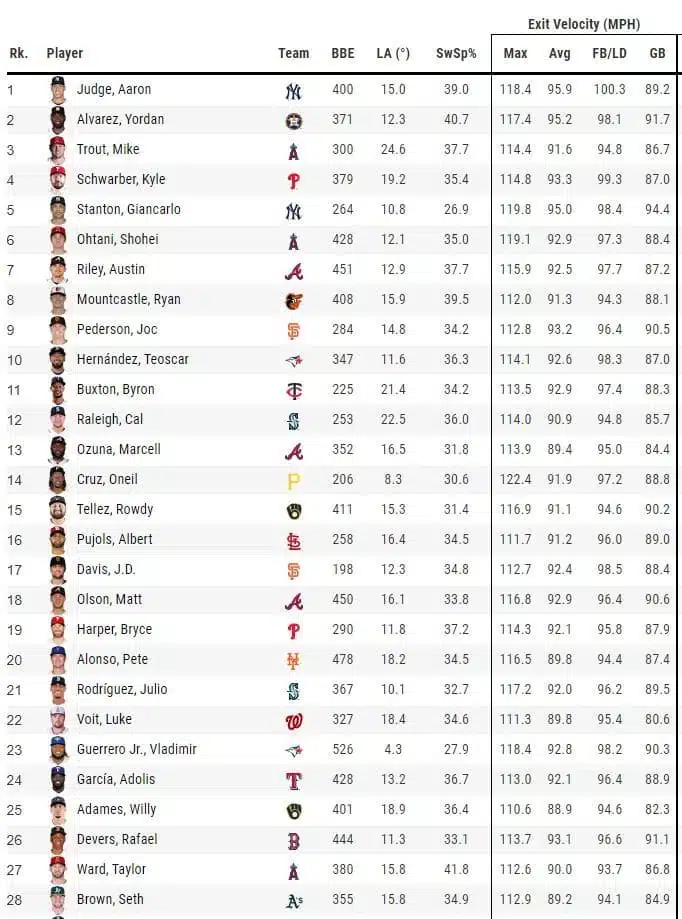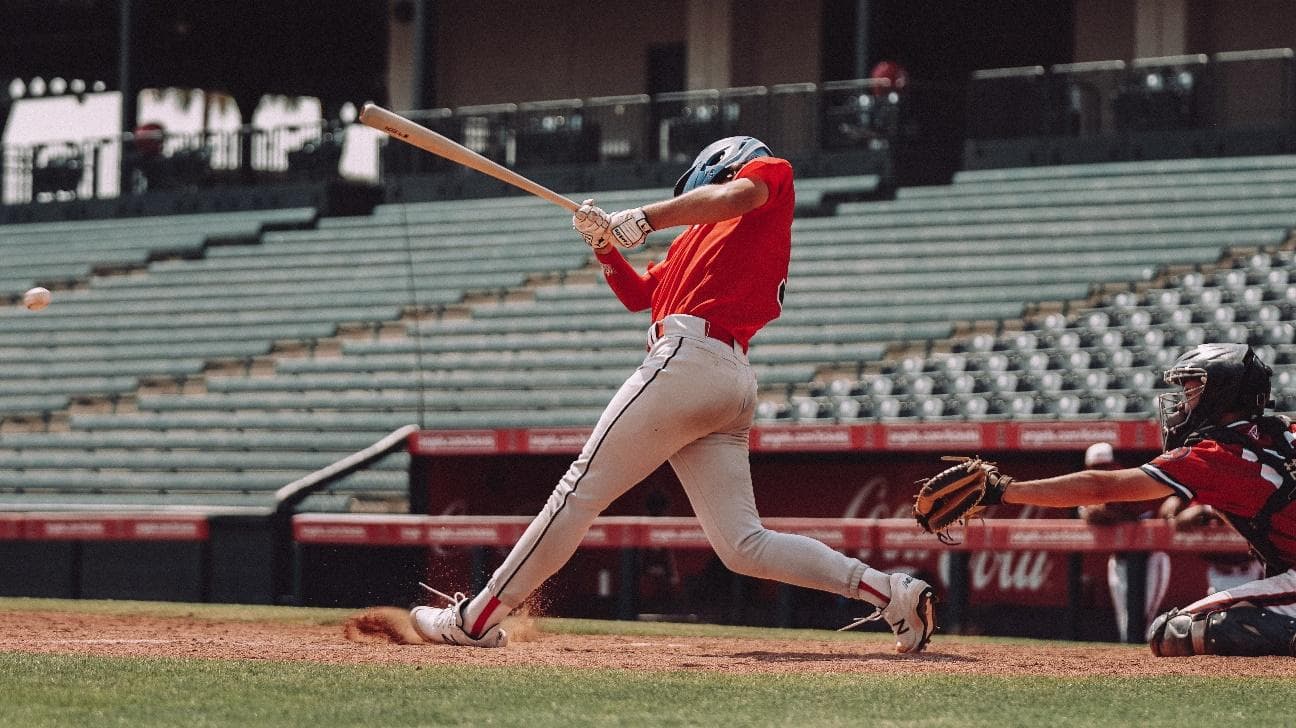8 de December de 2022
All About the Bat’s Exit Velocity and How to Improve It
What is Bat Exit Velocity and Why is it So Important in Baseball and Softball?

Image taken from Chris Chow (Unsplash)
Bat velocity is the speed with which the ball leaves the bat just after the impact (Nicholls, Elliott, Miller, & Koh, 2003). Exit velocity is one of the main metrics taken into account in baseball and softball. In fact, it is so important that a batter’s potential is measured primarily by his or her batting velocity or bat exit velocity (Whiteside, Martini, Zernicke, & Goulet, 2016). High bat exit velocity causes opponents have to react faster when defending. Adding a few more miles per hour to that bat exit velocity translates into more hits and more bases gained.
The pitcher’s goal will be to make it as difficult as possible for the batter to not get that high exit velocity off the bat. There are several factors involved in determining batting velocity that we will look at throughout this article. Some of them are the rate of batter force development, bat and pitch velocity, where the ball makes contact with the bat (Nathan, 2000), bat weight (Nicholls et al., 2003), and many others such as swing mechanics (Szymanski, Derenne, & Spaniol, 2009).
Difference between bat speed and bat exit velocity
The terms bat speed and bat exit velocity are often confused, but they don’t mean the same thing. The difference between one concept and the other is that bat exit velocity is the velocity of the ball immediately after impact with the bat, while bat speed is the velocity of the bat itself (Nicholls et al., 2003). Bat speed is the main factor that determines bat exit velocity. To track bat speed, the tip of the bat (barrel) is measured just prior to contact with the ball (Nicholls et al., 2003).
Another important factor for bat exit velocity is hitting the ball at the optimal point, known as the sweet spot (Nathan, 2003). This contact zone is where the least amount of vibration and energy loss occurs (Nathan, 2000). Therefore, the perfect combination that will give the maximum exit velocity is to hit the ball flush to that sweet spot with the maximum bat speed.
Does the bat influence the exit velocity?
The bat can be of greater or lesser weight, as well as wood or other material. Each of these factors affects the bat’s exit velocity, and also the risk of injury, both for the batter due to the repeated motions, and for the pitcher due to a possible impact of the ball at high velocity (Nicholls et al., 2003). A metal bat generates a higher exit velocity due to its elastic components that are not found in a wood bat. The distribution of masses along the length of the bat influences its moment of inertia, and thus its exit velocity, so the weight of the bat will also affect the exit velocity of the ball.
What is a good at-bat velocity depending on age?

Image taken by Eduardo Balderas (Unsplash)
Different platforms consulted yield information on the data that coaches have been collecting over the years. It’s not possible to state categorically, nor generalize, an average bat exit speed according to the age of the hitter because there are many factors that influence it, but as a reference, these are some figures:
- 8 – 9 years old: 42 – 45 mph (67 – 72 km/h).
- 10 – 11 years: 53 – 55 mph (85 – 88 km/h)
- 12 – 13 years: 59 – 65 mph (95 – 105 km/h)
- 14 – 15 years: 68 – 72 mph (109 – 116 km/h)
- 16 – 17 years: 74 – 79 mph (119 – 127 km/h)
Broadly speaking, and in a very general way those are the figures that various coaches have collected from their athletes over time. You can also group the average batting speed according to school level: secondary between 60 and 80 mph (96 – 129 km/h); college, or university students: between 70 – 90 mph (113 – 145 km/h); and professional : between 80 – 100 mph (129 km/h – 161 km/h). In all cases we are talking about average speed, not maximum speeds, which would be higher.
What is the average Division 1 batting velocity?
Division 1 (D1) is the category in which all high school baseball players want to play, but only a very small number of them make it. To get there requires a number of athletic traits such as a high average bat exit speed. It will be difficult to reach the D1 level without an exit velocity in the mid-90s or higher.
What is the bat exit velocity of professional MLB baseball players?
Here’s a video of Oneil Cruz’s record.
Major League Baseball (MLB) has had bat exit velocity tracking systems in place since 2015, thanks to the Statcast tool. The “Statcast era”, which is how the incorporation of this tool was named, has allowed to obtain bat exit velocity metrics, but also many other interesting ones, both for teams and spectators. The following image is a screenshot of the Statcast data, in which we can visualize the 2022 ranking, where both the maximum bat exit velocity and the average exit velocity of MLB professional players are displayed. The data is shown in miles per hour, so we would have to convert it to kilometers per hour.
In that ranking we can see that all MLB pros have a top exit ball speed of over 100 mph (160 km/h) and an average of about 85 – 90 mph (137 – 145 km/h). In 2022, Oneil Cruz had the highest bat exit velocity at 122.4 mph (197 km/h) and Aaron Judge had the highest average bat exit velocity with an average of 95.9 mph (154 km/h).

Screenshot extracted from Baseball Savant
How to improve bat exit velocity?

Image taken from Josh Hemsley (Unsplash)
Bat exit velocity depends on modifiable physical factors such as the athlete’s strength and its relationship to bat speed (Miyaguchi & Demura, 2012). Other technical factors such as swing time, swing mechanics, and swing angle are also influential (Sawicki, Hubbard, & Stronge, 2003). Some characteristics such as age or anthropometric proportions also affect bat exit velocity, but those we can’t modify (Szymanski et al., 2010).
If we focus on aspects such as strength and leave out the technical part, such as swing mechanics, it will not be optimal for improving bat exit velocity. Doing it the other way around will not be any more successful either. Therefore, we will have to increase our strength and polish our technique to improve our bat exit speed.
Velocity-based strength training to increase bat speed
Without forgetting the SAID principle that states that the human body adapts specifically to the imposed demands, we should train in a wide range of the velocity strength curve (Mann, Kazadi, Pirrung, & Jensen, 2021). Peak force will be useful to generate a base that will later be transformed into higher bat speed. The same will be true for all points on the force-velocity curve where we will work with high loads and slow speeds, and with low loads and high speeds. Of course, the intention should always be to move the loads as fast as possible, even if it looks slow from the outside.
The best strategy for strength training in baseball, softball and any sport is velocity-based training (VBT). This type of training allows us to individualize each athlete according to his or her strength-speed profile and fatigue status throughout the season (Zhang, Feng, Peng, & Li, 2022). VBT allows us to program loads very precisely, monitor fatigue in each set and in each workout and see if we are progressing (González-Badillo, Sánchez-Medina, Ribas-Serna, & Rodríguez-Rosell, 2022). If we are able to produce force faster, we have progressed, and that will be applied in a higher bat speed, and a higher bat exit velocity.
Rate of force development (RFD) is an explosive measure that indicates how fast an athlete can develop force (Aagaard, Simonsen, Andersen, Magnusson, & Dyhre-Poulsen, 2002). The greater the RFD, the greater the forces we can develop in a shorter period of time. To achieve this, we have to increase the rigidity of the muscle tendons, and increase the efficiency of the neural impulse, which is what connects the brain and the muscle. Programs that combine strength and power training are the most effective for improving the bat’s output velocity: maximal and submaximal strength; explosive training; Olympic movements; and plyometric training (DeRenne & Szymanski, 2009; Oliveira, Oliveira, Rizatto, & Denadai, 2013).
When it comes to programming training to improve bat exit velocity, the coach’s art of choosing the best exercises and loads for the athlete and the sport comes into play. For example, when it comes to batting, we must be very mindful of the rate of force development of trunk rotation, as it is vital to achieving greater bat exit velocity (Klein, Cobian, Simmons, & Reinold, 2021). To improve that trunk speed, as well as the rate of force development applied to batting, the best strategy is to perform velocity-based strength training. The training will be similar to what we have been doing, but a velocity measurement device such as Vitruve will show us in real time the speed of each repetition.
Heavier and lighter bats
When we want to improve a vertical jump we perform heavy squats, but also unloaded jumps, or even jumps with elastic band assistance to further increase the speed of the jump. When it comes to improving bat speed, and with it ball exit velocity, it is common to use bats with a heavier and lighter weight than what is usually used in competition (Reyes & Dolny, 2009).
Heavier bats than we normally use, help to develop specific strength in the swing. Lighter bats are used to give a sense of moving more explosively and cause the musculature to contract faster than it normally does. Properly timed training will introduce one type of bat or another depending on the demands of the athlete, as well as other bats that concentrate weight in a thicker handle with the same goal of increasing strength in swing movements (Laughlin, Fleisig, Aune, & Diffendaffer, 2016), and bat exit velocity as the end result.
Bat speed without control is useless: train and automate what you can control.
There is a maxim in training to increase bat exit velocity and that is that “the weight room complements the swing, but never take away from that swing”. Gaining strength is critical to our goal, but there are many more factors that affect that exit velocity such as swing mechanics (Szymanski et al., 2009), hitting angle, and all those technical factors that require great accuracy (Crisco, Osvalds, & Rainbow, 2018). Professional baseball players, such as Daniel Murphy, comment that there are very precise factors to increase bat exit velocity: “You want to hit the ball optimally around 25 degrees at 98 mph. Those are home runs.”
Therefore, the marriage of velocity-based strength training, the specificity of using heavier or lighter bats to transfer that force, and honing perfect batting technique are the three main strategies when it comes to improving bat exit velocity.
Joaquin Vico Plaza
References
Aagaard, P., Simonsen, E. B., Andersen, J. L., Magnusson, P., & Dyhre-Poulsen, P. (2002). Increased rate of force development and neural drive of human skeletal muscle following resistance training. Journal of Applied Physiology (Bethesda, Md. : 1985), 93(4), 1318–1326. https://doi.org/10.1152/JAPPLPHYSIOL.00283.2002
Crisco, J. J., Osvalds, N. J., & Rainbow, M. J. (2018). The Kinetics of Swinging a Baseball Bat. Journal of Applied Biomechanics, 34(5), 386–391. https://doi.org/10.1123/JAB.2017-0337
DeRenne, C., & Szymanski, D. J. (2009). Effects of baseball weighted implement training: A brief review. Strength and Conditioning Journal, 31(2), 30–37. https://doi.org/10.1519/SSC.0B013E31819D3396
González-Badillo, J. J., Sánchez-Medina, L., Ribas-Serna, J., & Rodríguez-Rosell, D. (2022). Toward a New Paradigm in Resistance Training by Means of Velocity Monitoring: A Critical and Challenging Narrative. Sports Medicine – Open 2022 8:1, 8(1), 1–24. https://doi.org/10.1186/S40798-022-00513-Z
Klein, B., Cobian, D., Simmons, G., & Reinold, M. (2021). Offseason Workout Recommendations for Baseball Players. Current Reviews in Musculoskeletal Medicine, 14(2), 174–184. https://doi.org/10.1007/S12178-021-09700-Z
Laughlin, W. A., Fleisig, G. S., Aune, K. T., & Diffendaffer, A. Z. (2016). The effects of baseball bat mass properties on swing mechanics, ground reaction forces, and swing timing. Sports Biomechanics, 15(1), 36–47. https://doi.org/10.1080/14763141.2015.1123762
Mann, B., Kazadi, K., Pirrung, E., & Jensen, J. (2021). Developing explosive athletes : use of velocity based training in athletes. Retrieved from https://books.google.com/books/about/Developing_Explosive_Athletes.html?hl=es&id=cA1pswEACAAJ
Miyaguchi, K., & Demura, S. (2012). Relationship between upper-body strength and bat swing speed in high-school baseball players. Journal of Strength and Conditioning Research, 26(7), 1786–1791. https://doi.org/10.1519/JSC.0B013E318236D126
Nathan, A. M. (2000). Dynamics of the baseball–bat collision. American Journal of Physics, 68(11), 979. https://doi.org/10.1119/1.1286119
Nathan, A. M. (2003). Characterizing the performance of baseball bats. American Journal of Physics, 71(2), 134. https://doi.org/10.1119/1.1522699
Nicholls, R. L., Elliott, B. C., Miller, K., & Koh, M. (2003). Bat Kinematics in Baseball: Implications for Ball Exit Velocity and Player Safety. Journal of Applied Biomechanics, 19(4), 283–294. https://doi.org/10.1123/JAB.19.4.283
Oliveira, F. B. D., Oliveira, A. S. C., Rizatto, G. F., & Denadai, B. S. (2013). Resistance Training for Explosive and Maximal Strength: Effects on Early and Late Rate of Force Development. Journal of Sports Science & Medicine, 12(3), 402. Retrieved from /pmc/articles/PMC3772581/
Reyes, G. F., & Dolny, D. (2009). Acute effects of various weighted bat warm-up protocols on bat velocity. Journal of Strength and Conditioning Research, 23(7), 2114–2118. https://doi.org/10.1519/JSC.0B013E3181B3DD32
Sawicki, G. S., Hubbard, M., & Stronge, W. J. (2003). How to hit home runs: Optimum baseball bat swing parameters for maximum range trajectories. American Journal of Physics, 71(11), 1152. https://doi.org/10.1119/1.1604384
Szymanski, D. J., Derenne, C., & Spaniol, F. J. (2009). Contributing factors for increased bat swing velocity. Journal of Strength and Conditioning Research, 23(4), 1338–1352. https://doi.org/10.1519/JSC.0B013E318194E09C
Szymanski, D. J., Szymanski, J. M., Schade, R. L., Bradford, T. J., McIntyre, J. S., DeRenne, C., & Madsen, N. H. (2010). The relation between anthropometric and physiological variables and bat velocity of high-school baseball players before and after 12 weeks of training. Journal of Strength and Conditioning Research, 24(11), 2933–2943. https://doi.org/10.1519/JSC.0B013E3181F0A76A
Whiteside, D., Martini, D. N., Zernicke, R. F., & Goulet, G. C. (2016). Ball Speed and Release Consistency Predict Pitching Success in Major League Baseball. Journal of Strength and Conditioning Research, 30(7), 1787–1795. https://doi.org/10.1519/JSC.0000000000001296
Zhang, X., Feng, S., Peng, R., & Li, H. (2022). The Role of Velocity-Based Training (VBT) in Enhancing Athletic Performance in Trained Individuals: A Meta-Analysis of Controlled Trials. International Journal of Environmental Research and Public Health, 19(15). https://doi.org/10.3390/IJERPH19159252

